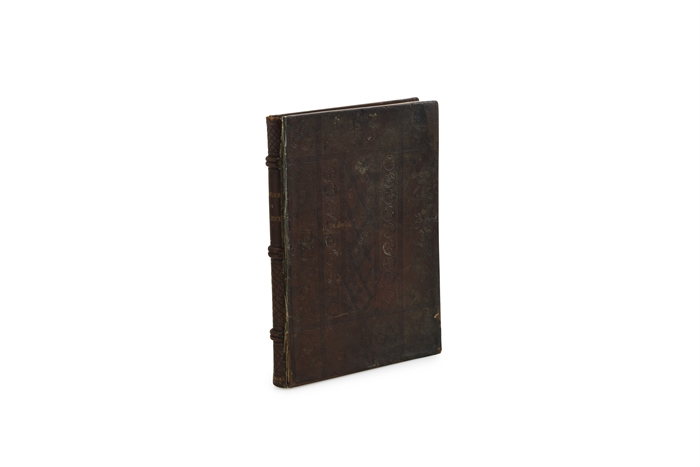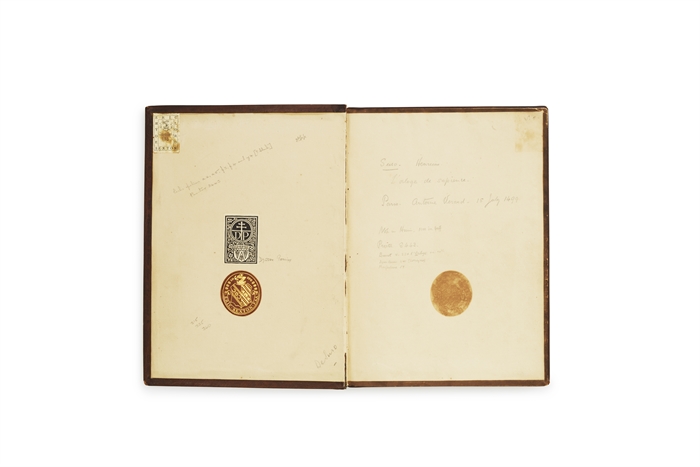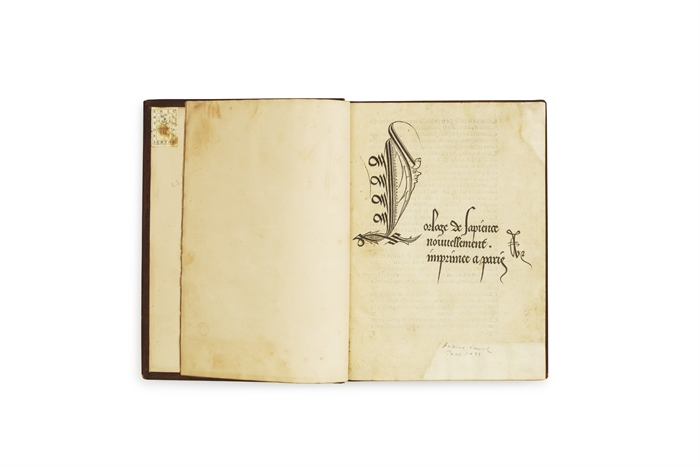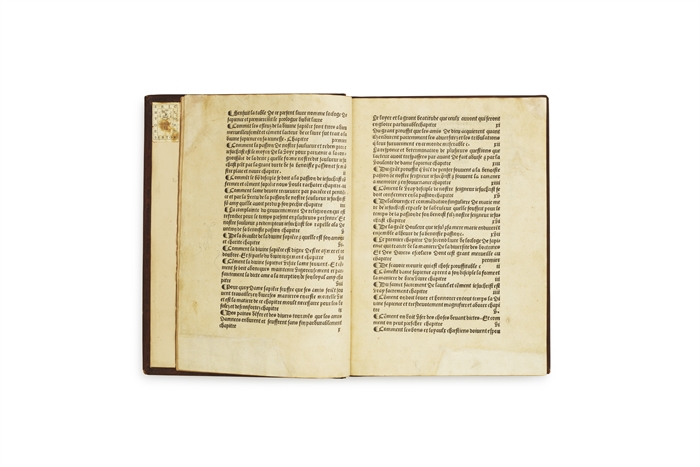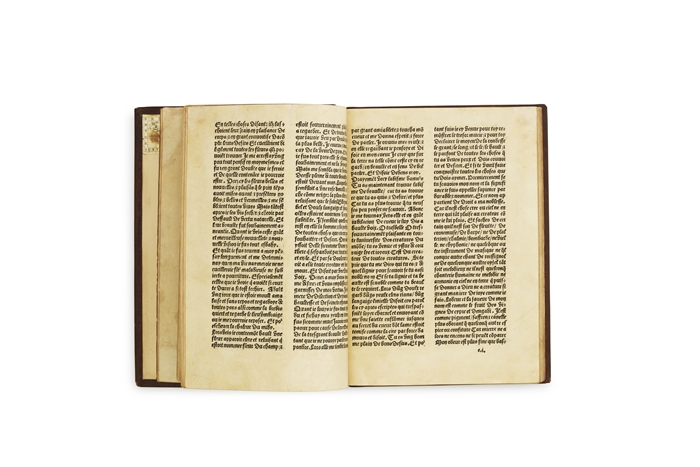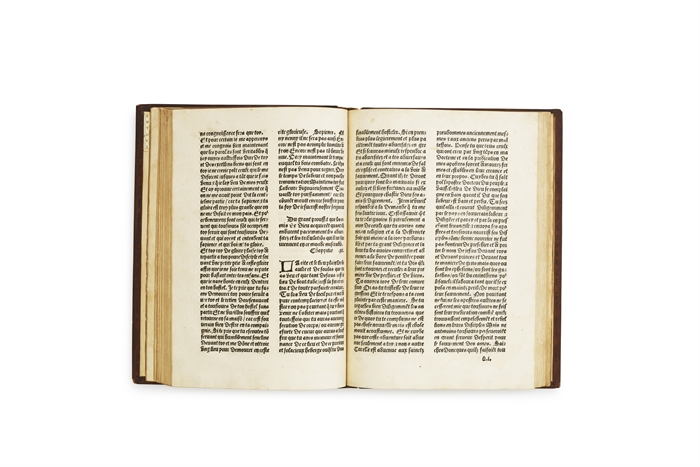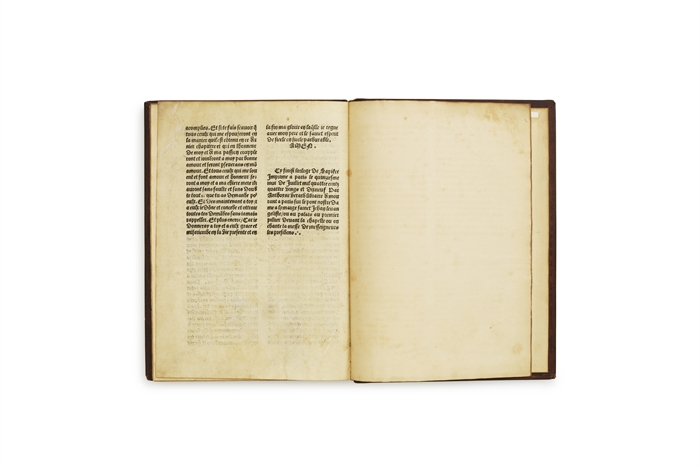EXCEEDINGLY RARE INCUNABLE-EDITION - THE DYSON PERRINS-COPY
SUSO, HENRICUS.
L'orloge de sapience nouvellement imprimee.
Paris, Verard, July 15. 1499.
Folio (265 x 200 mm). In early full blindstamped calf, rebacked. All edges gilt. Edges and margin of boards with wear and repairs. Hinges weak. With the ex-libris of C. W. Dyson Perrins and Eric Sexton to pasted down front end-paper. First 6 leaves with portions of lower and upper blank margins renewed, not affecting text. Some repairs throughout, but mainly in margins. 36 lines to a page. Woodcut calligraphic title-page with Verard's initials. Overall a very nice copy of this rare work. 127 ff. (out of 132 ff. Lacking a2, a5, b3, l4, y4 and possibly a blank).
Exceedingly rare second French edition of the famous and highly popular work by the Dominican mystic Henry of Suso, the much-celebrated devotional text The Clock of Wisdom, which has been called the finest fruit of German mysticism. It is one of the most influential late medieval spiritual texts and has often been compared to Boethius’ Consolation of Philosophy, sometimes described as a Christian mystical counterpart to it. The book is written as a dialogue between the soul and divine wisdom personified as Christ. It is deeply influenced by Suso’s own mystical experiences and his desire for union with God through suffering, love and humility. The recurring metaphor of the clock represents the ordered rhythm of the spiritual life, where each moment should be dedicated to contemplation, prayer, and divine love. Suso’s work was much inspired by Boethius’ Consolation of Philosophy and is to a large extend constructed the same way; Suso has even been referred to as the "Christocentric Boethius". While Boethius seeks to understand divine wisdom through reason and philosophical arguments, Suso emphasizes intimate and experiential knowledge of divine love through suffering, devotion, and contemplation. The popularity of the Horologium Sapientiae, if the number of surviving copies is any guide, was extraordinary. Recent research suggests some 233 complete copies exist and another 88 are seemingly lost. “That [the present work] was, in the fourteenth century and thereafter, one of the three most popular devotional treatises in Western Europe, we have much evidence. Its only two rivals in general esteem were the pseudo-Bonaventure’s Meditations on the Life of Christ and Ludolph of Saxony’s Life of Christ. Pseudo-Bonaventure’s Meditations is an older work; internal evidence points to its composition in the earliest years of the century. ... Curiously, despite its popularity and numerous printed editions, it rarely finds its way into the trade. At eighteen, Suso commenced a mystical life, dedicating himself to "Eternal Wisdom" which he identified with the Divine. He experienced visions, practiced austerities and endured self-inflicted suffering. By 1334 he embarked on an apostolic career, serving as prior of a convent (probably in Diessenhofen) before moving to Ulm where he stayed until his death. Suso’s first work, “Büchlein der Wahrheit”, written in Cologne was much criticized but deemed orthodox. His “Büchlein der ewigen Weisheit” (1328), addressing spiritual seekers, became one of the most widely read German meditation books. In 1334, he expanded it into the present work which became even more popular. Brunet IV, 234.
This edition is of the utmost scarcity: OCLC lists no copies and we have only been to trace one copy in the trade, namely the present (Sold at the Dyson Perrins-sale in 1946 and again in 1956).
Suso also writes about his longing for piety and the simplicity of life he had seen as a young man which he considered lost and forgotten in the new urban cultures.
The first printed Latin edition seems to have appeared in Cologne, c. 1480, and in the years before 1540 nine others are known, two from Paris, four more from Cologne, one from Aals and two from Venice. All this points to the work’s extravagant success in its first years after publication, a success that did not diminish until Europe was split into contending camps, in one of which Catholic teaching and devotion were no longer acceptable.” (Introduction to; Wisdom's Watch upon the Hours: The Fathers of the Chuch (Mediaeval Continuation), College, 2013).
Henry Suso (Heinrich Seuse or Heinrich von Berg, 1295 – 1366) was a German Dominican friar and one of the most popular vernacular writer of the fourteenth century also famous for defending Meister Eckhart's legacy after Eckhart was posthumously condemned for heresy in 1329
Order-nr.: 62021

